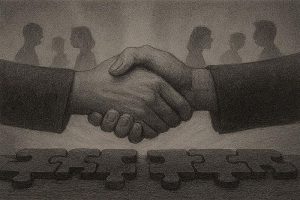Chrysalis started on its 29th year this month. As it always happens, this for me becomes a time of rumination. The one big thing in my reflection was the number of transformations that are taking place in our world. Earlier on, change would unfold in cycles of decades if not more. However, it is today, it sweeps through in a matter of months and days. The world we live in is a state of not just change but dizzying transformation. Being a Learning and Human Capability or a People Professional for over 30 years, I ended up thinking about what will be and what can be in the area I work in.
The world of tomorrow is a theme that has been constantly coming up in all my significant conversations with clients and leaders. There are mega trends and micro trends that are sweeping through our world. What took Netflix years in terms of users – took Chat GPT days. We’re not teetering on the brink of the future; we’re already living in it.
Now that brings me to what I am hearing. Artificial Intelligence is here and to stay. It is already having far-reaching ramifications on the world – life and work. The points of view around this are bipolar. There are diametrically opposite perspectives on the World, Work, and Work Force of Tomorrow. While one set of people are predicting a takeover by technology and the AI Apocalypse – the other set presents a very optimistic view of how life and work will become easier and unhindered.
The questions about human beings becoming redundant and the loss of jobs because of technological advancement is a big concern of the fearmongers. The labour markets across the globe are changing in response to the mega-trends of technology and all that comes associated with it. Being the optimist that I am, I see opportunity in everything that is happening around us. For me, the penny dropped when an expert in AI said, “You don’t need to fear AI – you need to look at it as an extra brain that you will have to work with. Think of it as doubling your cognitive power.”

I am no expert in technology and am certainly not intelligent about artificial intelligence. But even I can see the world is transforming and the workplace is struggling to keep pace. In a scenario like this, where the future is fraught with uncertainty and ambiguity, learning within an organization no longer has the luxury to play second fiddle to operations – it can no longer be laid back in its role as an enabling function.
Therefore, the onus lies on us – the HR, Talent, and Learning fraternity to reimagine the ways in which the Learning function will evolve in the next 5-7 years. Learning and Development will never get sidelined, it will only get honed wherein the methodologies and pedagogies will change in order to cater to the demands of the future workforce. We are the anchors that organizations need to maintain higher skills and enhanced human thinking and capabilities amidst technology that may be more intelligent. AI may generate information at the snap of our fingers but how do we use the overflow of information to better business results. The standard business playbooks are being re-written in front of our eyes, and we need to ensure we are not stuck in the hyperfocus of the short term. The demands on the Learning teams will be significantly higher to create a value proposition that is relevant, adaptable, and compelling for the workforce. This brings me back to the present where I am working with clients to understand their current needs and envision future needs of a future-ready workforce. This time around, in the cycle of transformations, the “training versus learning” debate is slowly growing irrelevant. Learning itself will need to be reimagined so that it becomes more broad-based and effectively drives organizational growth and scale. So, if we are to reimagine the Learning function today for tomorrow, we need to understand not what the future of work is – but what is the work of the future.

The work of the future will evolve but to stay ahead of the curve, People Professionals within organizations must look at 5 Influencing Forces:
- The First Force – Consumer Trends – Expectations, Drivers, Activism
The starting point of all businesses is the consumer need that it fulfills. In today’s world, consumer trends are dynamic and complex. With people living longer, then the question to ask is how you will equip people within your organization or industry to understand consumer expectations and fulfill their needs. The capabilities to pick up the nuances of what human beings want, and need will need to be honed in people. A domain of marketing previously, People Professionals also need to discern how consumers are making choices and what is the evolution of their needs. - The Second Force – Environmental, Social, Governance – Considerations, Commitments
We need to understand the impact we are having on the world as humans and as businesses. Environmental, Social, and Governance (ESG) factors have gained significant importance in the business world. These are being discussed by Boards of Directors and measured because of their mandates. To reimagine the future of Learning, we need to recognize the need to integrate ESG considerations to drive sustainable growth, mitigate risks, and meet stakeholder expectations. The HR and Talent functions play a pivotal role in ensuring that ESG principles are integrated throughout the organization. We need to help employees understand how in the workplace of tomorrow, impact the ESG standards of the organization. We need to help teams co-create environments and cultures to foster diversity, equity, and inclusion within the organization. We need to make leadership more cognizant of their role in the societies they operate. We need to help our organizations create a more sustainable world. The investments we make in terms of time, money, and resources need to be clearly charted based on the future needs rather than falling prey to standard allocations. - The Third Force – Business Model and Process – Change, Innovation, Future-Proofing
In the last 4 years, we have seen organizations accelerate their agility in reimagining technology and business processes to meet current demands. That, however, is not enough for us to reimagine the future. As People Professionals, we need to ask questions we have never asked before. Based on the work and workforce of the future, we need to reflect on our business models and processes to gauge their relevance for the future. According to a report by Dell Technologies, 85% of jobs that will exist in 2030 haven’t been invented yet. In the future, job descriptions will be changing almost side-by-side with market needs, while also becoming more self-directed. Engaging in conversations with our business leaders on if we were to start our business again today how will we go about it – is a starting point for us as People Professionals to understand the changing alternatives of business models and processes. - The Fourth Force – Employee Trends – Reality, Expectations, Engagement
To reimagine the future, it is critical for us to understand what our employees want and what will keep them engaged. The last few years have seen the weekend fathers, the single moms, the shared custody parents, couples married and working in different cities. For us, as People Professionals, to understand employee trends, we need to plug into the societal trends of tomorrow. The trends that you are seeing in societies, communities and families will impact the trends that we will need to learn from. The music, entertainment, and movies often act as a harbinger of the times to come. The demographics and psychographics will be a clue to understanding the employees of the future and their aspirations and expectations. We need to move away from generation bashing and accept the strengths that each generation brings. As People Professionals, engaging with future workforces will help us glean perspectives that we may not have currently. Our roles will be to understand and appreciate and not judge and ascribe value. - The Fifth Force – Technology Interplay – Organization, Employee, Customer
The time for silos has gone, especially for People Professionals. Thinking of the future of learning without understanding technology is counter intuitive. Stepping out of our comfort zones to experiment with technologies is a must. This will help us gain the confidence to explore possibilities of the interplay between the organization, the employee and the customer on the back of technology that will emerge. We must catch those delicate waves of change around the impact of technology on the future customer cycles, the domino effect it will have on employees’ roles and therefore the requirement for organizational capabilities that may not exist today. This is a proactive step that will help you scan not just today’s environment but also what it could be in the coming years.

Therefore, what is the work that will need to be done by our people and the human capability transformation that needs to be undertaken? As People Professionals, we need to be viable in the marketplace. We need to intentionally design the workplace experience with the employee at the center. By leaning into employee conversations and interactions, we will be able to read the signs before they are too late. We need to be broadminded in the truest sense and ride the waves of change. To do this, we need to scan trends, emotions, aspirations, fads, fancies of our employees.
Doing this regularly and often will increase the ability to embark on the journey of reimagining learning. I must caution you though, that all of this happens simultaneously – much like changing tires of a running car.
Stay tuned in for more.


